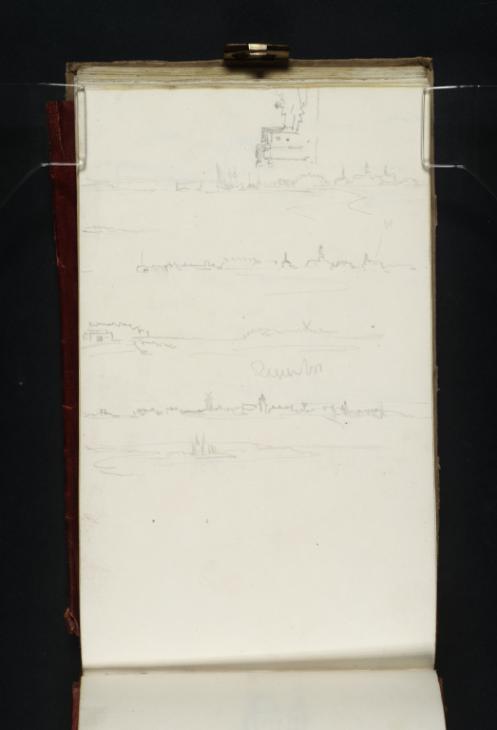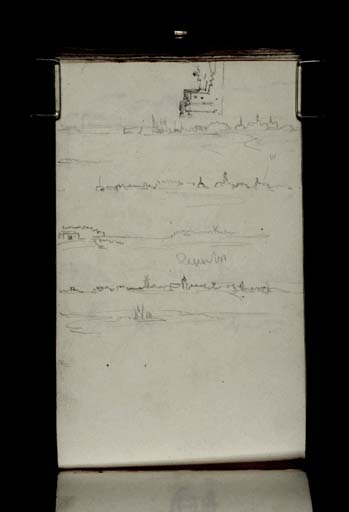Joseph Mallord William Turner At Sheerness and Queenborough c.1821
Image 1 of 2
Joseph Mallord William Turner,
At Sheerness and Queenborough
c.1821
Joseph Mallord William Turner 1775–1851
Folio 86 Verso:
At Sheerness and Queenborough c.1821
D17499
Turner Bequest CXCIX 86a
Turner Bequest CXCIX 86a
Pencil on white wove paper, 112 x 190 mm
Inscribed by Turner in pencil ‘w’ towards top right, ‘Queenboro’ at centre
Inscribed by Turner in pencil ‘w’ towards top right, ‘Queenboro’ at centre
Accepted by the nation as part of the Turner Bequest 1856
References
1909
A.J. Finberg, A Complete Inventory of the Drawings of the Turner Bequest, London 1909, vol.I, p.609, CXCIX 86 a, as ‘Views of “Queensboro’”’.
1984
Craig Hartley, Turner Watercolours in the Whitworth Art Gallery, exhibition catalogue, Whitworth Art Gallery, Manchester 1984, p.49 under no.39.
1989
Ann Sumner, Ruskin and the English Watercolour: From Turner to the Pre-Raphaelites, exhibition catalogue, Whitworth Art Gallery, Manchester 1989, p.50 under no.71.
1997
Charles Nugent and Melva Croal, Turner Watercolors from Manchester, exhibition catalogue, Memphis Brooks Museum of Art, Memphis 1997, p.86 under no.52.
Made with the sketchbook turned vertically, the drawings on this page predominantly describe panoramic views of towns.
The top two prospects show from a distance the cluttered harbour view of Sheerness, described elsewhere on folios 11 verso, 12 recto, 12 verso, and 90 verso (D17383–D17385, D17507). For an indication of the prevalence of Sheerness within Turner’s oeuvre more generally, refer to the entry for folio 12 verso. Here, in both instances Turner seems to sketch Sheerness from a position along the pier, or sea wall promenade, a small winding section of which is evident in the foreground of both views.
The third scene, across the middle of the page, is less definitive in its composition, showing a dwelling at left, and a stretch of riverbank or harbour across the right with a town and windmill beyond.
Fourth from the top, a view of Queenborough on the Isle of Sheppey is identified by Turner with an explicitly informative inscription. It shows at centre the distinctive profile of the Holy Trinity Church against the sky, observed from a southern viewpoint. To the northwest, a tall mill breaks the horizon. This arrangement is repeated in a sketch on folio 85 verso (D17497) and possibly also much earlier on folio 8 recto (D17378). Beneath the present scene at Queenborough, Turner renders a light, fluid, topographic view, punctured at centre by a group of vertical lines. The expanse of water is presumably the River Swale.
This page has often been cited by art historians charting the prevalence and relevance of sketches of Upnor Castle in this sketchbook. Scholars agree that Turner used material from this book to inform the watercolour Upnor Castle, Kent of around 1831 (Whitworth Art Gallery)1 engraved by J.B. Allen for the England and Wales series and published in 1833 (Tate impression T06102). More specifically, the basis of the composition is thought to be a drawing made across folios 87 verso and 88 recto (D17501 and D17502), inverted in relation to the foliation of the sketchbook, which spills over on to the current sheet in order to include ‘the right hand end of the castle’.2 Pressed for space at the rightmost edge of folio 87 verso, Turner appears to have slid the page towards the left, revealing enough blank space beneath to record his impression of the landmark. The results of this can be perceived at the top of the present sheet, which is here oriented vertically to account for Turner’s predominant use of it when describing additional scenes. For more information about Upnor Castle, and a comprehensive list of the folios in this book which display views of it, see the entry for folio 87 verso (D17501).
Maud Whatley
January 2016
How to cite
Maud Whatley, ‘At Sheerness and Queenborough c.1821 by Joseph Mallord William Turner’, catalogue entry, January 2016, in David Blayney Brown (ed.), J.M.W. Turner: Sketchbooks, Drawings and Watercolours, Tate Research Publication, February 2017, https://www


